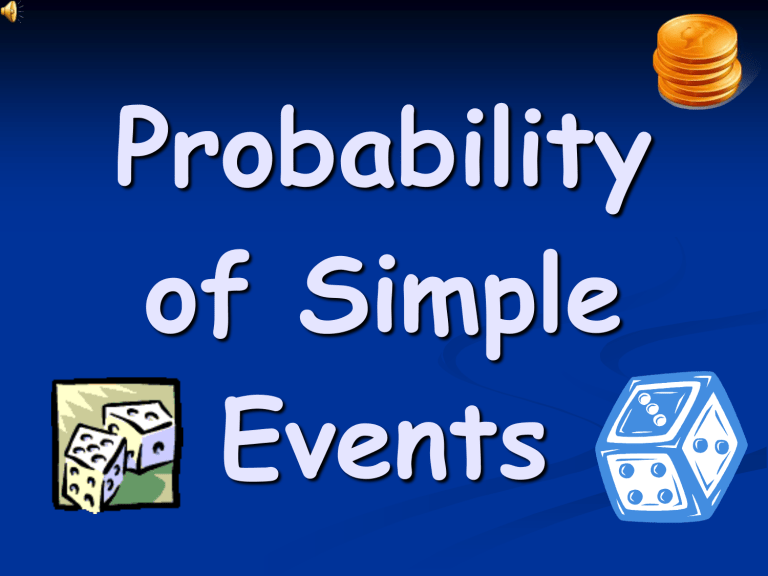
Probability of Simple Events Probability of Simple Events Objective: Students will be able to find the probability of a simple event. Students will be able to understand the distinction between simple events and compound events. Essential Question: (1) How do I find the probability of a simple event? (2) How can I distinguish between a simple and compound event? Probability of Simple Events Vocabulary: Outcome – one possible result of a probability. Sample Space – the list of possible outcomes for a probability event. Random – outcomes that occur at random if each outcome is equally likely to occur. Simple Event – a specific outcome or type of outcome. Complementary Events – the events of one outcome happening and that outcomes not happening are complimentary; the sum of the probabilities of complementary events is 1. Probability of Simple Events Real World Example: Best Buy is having an IPOD giveaway. They put all the IPOD Shuffles in a bag. Customers may choose an IPOD without looking at the color. Inside the bag are 4 orange, 5 blue, 6 green, and 5 pink IPODS. If Maria chooses one IPOD at random, what is the probability she will choose an orange IPOD? Probability of Simple Events Real World Example: Best Buy is having an IPOD giveaway. They put all the IPOD Shuffles in a bag. Customers may choose an IPOD without looking at the color. Inside the bag are 4 orange, 5 blue, 6 green, and 5 pink IPODS. If Maria chooses one IPOD at random, what is the probability she will choose an orange IPOD? P(orange) = 4/20 = 2/10 = 1/5 or 20% Probability of Simple Events What is a PROBABILITY? - Probability is the chance that some event will happen - It is the ratio of the number of ways a certain event can occur to the number of possible outcomes Probability of Simple Events What is a PROBABILITY? P(event) = number of favorable outcomes number of possible outcomes Examples that use Probability: (1) Dice, (2) Spinners, (3) Coins, (4) Deck of Cards, (5) Evens/Odds, (6) Alphabet, etc. Probability of Simple Events What is a PROBABILITY? 0% 25% 50% 75% 100% 0 ¼ or .25 ½ 0r .5 ¾ or .75 1 Impossible Not Very Likely Equally Likely Somewhat Likely Certain Probability of Simple Events Example 1: Roll a dice. What is the probability of rolling a 4? # favorable outcomes P(event) = # possible outcomes 1 P(rolling a 4) = 6 The probability of rolling a 4 is 1 out of 6 Probability of Simple Events Example 2: Roll a dice. What is the probability of rolling an even number? # favorable outcomes P(event) = # possible outcomes 3 1 P(even #) = = 6 2 The probability of rolling an even number is 3 out of 6 or .5 or 50% Probability of Simple Events Example 3: Spinners. What is the probability of spinning green? # favorable outcomes P(event) = # possible outcomes 1 1 P(green) = = 4 4 The probability of spinning green is 1 out of 4 or .25 or 25% Probability of Simple Events Example 4: Flip a coin. What is the probability of flipping a tail? # favorable outcomes P(event) = # possible outcomes 1 1 P(tail) = = 2 2 The probability of spinning green is 1 out of 2 or .5 or 50% Probability of Simple Events Example 5: Deck of Cards. What is the probability of picking a heart? P(heart) = # favorable outcomes = 13 = # possible outcomes 52 The probability of picking a heart is 1 out of 4 or .25 or 25% 1 4 What is the probability of picking a non heart? P(nonheart) = # favorable outcomes = 39 # possible outcomes 52 The probability of picking a heart is 3 out of 4 or .75 or 75% = 3 4 Probability of Simple Events Key Concepts: - Probability is the chance that some event will happen - It is the ratio of the number of ways a certain even can occur to the total number of possible outcomes Probability of Simple Events Guided Practice: Calculate the probability of each independent event. 1) P(black) = 2) P(1) = 3) P(odd) = 4) P(prime) = Probability of Simple Events Guided Practice: Answers. 1) P(black) = 4/8 2) P(1) = 1/8 1 3) P(odd) = /2 1 4) P(prime) = /2 Probability of Simple Events Independent Practice: Calculate the probability of each independent event. 1) P(red) = 2) P(2) = 3) P(not red) = 4) P(even) = Probability of Simple Events Independent Practice: 1) P(red) = 1/2 2) P(2) = 1/4 1 3) P(not red) = /2 1 4) P(even) = /2 Answers. Probability of Simple Events Real World Example: A computer company manufactures 2,500 computers each day. An average of 100 of these computers are returned with defects. What is the probability that the computer you purchased is not defective? P(not defective) = # not defective total # manufactured = 2,400 = 24 2,500 25 Probability of Simple Events Thank You !!

